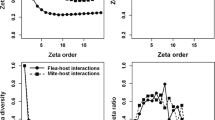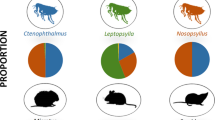Abstract
Host individuals not infested by parasites at a given time are either permanently free from parasites or could be infested at other times. We studied temporal variation in the presence or absence of fleas (Siphonaptera) on individual rodents of two species (Gerbillus dasyurus and Acomys cahirinus) and questioned if and how an individual rodent can change its infestation status temporally. Change in infestation status by fleas over time was found in 45.5% of G. dasyurus and 35.9% of A. cahirinus. In both host species, the proportion of individuals that either changed or did not change their infestation status did not differ from the null expectation of 1:1. No difference between the proportions of infested at two consecutive captures and uninfested at two consecutive captures animals was found in A. cahirinus, whereas the proportion of G. dasyurus infested by fleas at two consecutive captures was significantly greater than that of uninfested at two consecutive captures individuals. In both host species, similar proportions of individuals changed their infestation status either from being infested to being uninfested or vice versa. Among individuals of both species that were initially infested by fleas, similar proportions changed and did not change their subsequent infestation status. The same was true for the uninfested at the first capture A. cahirinus. However, among initially uninfested G. dasyurus, the proportion of individuals that remained uninfested was significantly greater than that of the individuals newly infested by fleas. In A. cahirinus, the probability to change the infestation status did not depend on the initial status of an individual. In G. dasyurus, the probability of the initially uninfested individuals to be subsequently found still uninfested was higher than to be subsequently found harboring fleas, whereas initially infested individuals could be subsequently found either still infested or flea-free with equal probability.

Similar content being viewed by others
References
Anderson RM, May RM (1978) Regulation and stability of host–parasite population interactions. I. Regulatory processes. J Anim Ecol 47:219–247
Bartolomucci A, Palanza P, Gaspani L, Limiroli E, Panerai AE, Ceresini G, Poli MD, Parmigiani S (2001) Social status in mice: behavioral, endocrine and immune changes are context dependent. Physiol Behav 73:401–410
Brandt CA (1992) Social factors in immigration and emigration. In: Stenseth NC, Lidicker WZ (eds) Animal dispersal. Small mammals as a model. Chapman and Hall, London, pp 96–141
Combes C (2001) Parasitism. The ecology and evolution of intimate interactions. University of Chicago Press, Chicago
Demas GE, Nelson RJ (1998) Photoperiod, ambient temperature, and food availability interact to affect reproductive and immune function in adult male deer mice (Peromyscus maniculatus). J Biol Rhythms 13:253–262
Gliwicz J (1992) Patterns of dispersal in non-cyclic populations of small rodents. In: Stenseth NC, Lidicker WZ (eds) Animal dispersal. Small mammals as a model. Chapman and Hall, London, pp 147–159
Gotelli NJ, Rohde K (2002) Co-occurrence of ectoparasites of marine fishes: a null model analysis. Ecol Lett 5:86–94
Gray CA, Gray PN, Pence DB (1989) Influence of social status on the helminth community of late-winter mallards. Can J Zool 67:1937–1944
Gromov VS, Krasnov BR, Shenbrot GI (2000) Space use in Wagner’s gerbil Gerbillus dasyurus in the Negev Highlands, Israel. Acta Theriol 45:175–182
Halvorsen O (1985) On the relationship between social status of a host and risk of parasitic infection. Oikos 47:71–74
Khokhlova IS, Krasnov BR, Shenbrot GI, Degen AA (2000) Body mass and environment: a study in Negev rodents. Isr J Zool 47:1–14
Krasnov BR, Shenbrot GI, Khokhlova IS, Ivanitskaya EY (1996) Spatial structure of rodent community in the Ramon erosion cirque, Negev highlands (Israel). J Arid Environ 32:319–327
Krasnov BR, Shenbrot GI, Medvedev SG, Vatschenok VS, Khokhlova IS (1997) Host–habitat relations as an important determinant of spatial distribution of flea assemblages (Siphonaptera) on rodents in the Negev Desert. Parasitology 114:159–173
Krasnov BR, Hastriter M, Medvedev SG, Shenbrot GI, Khokhlova IS, Vaschenok VS (1999) Additional records of fleas (Siphonaptera) on wild rodents in the southern part of Israel. Isr J Zool 45:333–340
Krasnov BR, Burdelova NV, Shenbrot GI, Khokhlova IS (2002a) Annual cycles of four flea species (Siphonaptera) in the central Negev desert. Med Vet Entomol 16:266–276
Krasnov BR, Khokhlova IS, Shenbrot GI (2002b) The effect of host density on ectoparasite distribution: an example with a desert rodent parasitized by fleas. Ecology 83:164–175
Krasnov BR, Khokhlova IS, Arakelyan MS, Degen AA (2005) Is a starving host tastier? Reproduction in fleas parasitizing food limited rodents. Funct Ecol 19:625–631
Morand S, Pointier J-P, Borel G, Theron A (1993) Pairing probability of schistosomes related to their distribution among the host population. Ecology 74:2444–2449
Nikitina NA (1961) Results of marking small mammals in the Komi Soviet Republic. Bull Moscow Nature Soc 66:15–25 (in Russian)
Poulin R (1993) The disparity between observed and uniform distributions: a new look at parasite aggregation. Int J Parasitol 23:937–944
Poulin R (1998) Evolutionary ecology of parasites. From individuals to communities. Chapman and Hall, London
Rosenthal CM, Bennett NC, Jarvis JU (1992) The changes in the dominance hierarchy over time of a complete field-captured colony of Cryptomys hottentotus hottentotus. J Zool (Lond) 228:205–225
Shargal E, Kronfeld-Schor N, Dayan T (2000) Population biology and spatial relationships of coexisting spiny mice (Acomys) in Israel. J Mammal 81:1046–1052
Shaw DJ, Dobson AP (1995) Patterns of macroparasite abundance and aggregation in wildlife populations: a quantitative review. Parasitology 111:S111–S127
Sheldon BC, Verhulst S (1996) Ecological immunology: costly parasite defenses and trade offs in evolutionary ecology. Trends Ecol Evol 11:317–321
Shenbrot GI, Krasnov BR, Khokhlova IS (1997) On the biology of Wagner’s gerbil (Gerbillus dasyurus (Wagner, 1842) (Rodentia: Gerbillidae) in the Negev Highlands, Israel. Mammalia 61:467–486
Simkova A, Kadlec D, Gelnar M, Morand S (2002) Abundance-prevalence relationship of gill congeneric ectoparasites: testing the core satellite hypothesis and ecological specialization. Parasitol Res 88:682–686
Sorci G (1996) Patterns of haemogregarine load, aggregation and prevalence as a function of host age in the lizard Lacerta vivipara. J Parasitol 82:676–678
Smith A (1980) Lack of interspecific interactions of Everglades rodents on two spatial scales. Acta Theriol 25:61–70
Wilson K, Bjørnstad ON, Dobson AP, Merler S, Poglaen G, Randolph SE, Read AF, Skorping A (2001) Heterogeneities in macroparasite infections: Patterns and processes. In: Hudson PJ, Rizzoli A, Grenfell BT, Heesterbeek H, Dobson AP (eds) The ecology of wildlife diseases. Oxford University Press, Oxford, pp 6–44
Acknowledgements
This study was partly supported by the Israel Science Foundation (Grant no. 249/04). This is publication no. 205 of the Ramon Science Center and no. 525 of the Mitrani Department of Desert Ecology.
Author information
Authors and Affiliations
Corresponding author
Rights and permissions
About this article
Cite this article
Krasnov, B.R., Shenbrot, G.I., Khokhlova, I.S. et al. Temporal variation in parasite infestation of a host individual: does a parasite-free host remain uninfested permanently?. Parasitol Res 99, 541–545 (2006). https://doi.org/10.1007/s00436-006-0201-4
Received:
Accepted:
Published:
Issue Date:
DOI: https://doi.org/10.1007/s00436-006-0201-4




